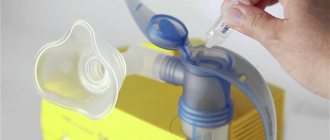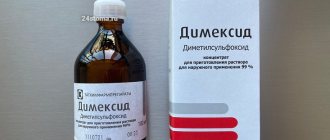Many patients with a similar diagnosis are interested in whether it is possible to do inhalations for laryngitis? Doctors say that such procedures are quite effective in eliminating the inflammatory process.
Inhalations promote a speedy recovery due to the processes occurring in the larynx:
- liquefy mucus that accumulates and settles on the larynx and pharynx;
- dilute mucus and promote its rapid removal;
- moisturize the mucous membrane of the upper respiratory canal;
- relieves the larynx from swelling;
- reduce the risk of developing laryngospasms;
- reduce the inflammatory process;
- prevent the growth of bacteria;
- improve the functioning of the mucous membrane;
- promote rapid healing of damaged tissues;
- eliminate accompanying symptoms;
- prevent the development of various complications that can result in bronchitis and tracheitis.
Thanks to all these useful actions, inhalations for inflammation of the larynx can become one of the main methods of therapy.
The duration of the procedures is regulated by the attending physician. Sometimes symptoms go away after just a few inhalations.
When asked whether it is possible to do inhalations for acute, chronic, hypertrophic and atrophic laryngitis, experts point out that all these forms of the disease are indications for this procedure. However, steam inhalations are carried out only for viral inflammation of the larynx. The doctor can prescribe them after the main treatment of the acute phase.
Chronic laryngitis can be treated at home. Thanks to inhalations, the mucous membrane of the larynx will recover faster.
In addition, you need to remember that you can do inhalations for laryngitis if there is a risk of developing rhinitis (acute inflammation of the nasal mucosa), pharyngitis (inflammation of the lymphoid tissues of the throat) and tracheitis (inflammation of the trachea).
In what cases are inhalations contraindicated?
There are two types of inhalers - ultrasonic and nebulizer. They are both easy to use. Medicinal components easily penetrate the area of inflammatory processes.
Inhalation with a nebulizer is contraindicated in the following cases:
- heat;
- tendency to nosebleeds;
- severe cardiac and vascular pathologies;
- diseases that lead to unstable heart rhythm;
- bronchial asthma;
- severe laryngitis;
- individual intolerance to the active components of the drug used.
As with any treatment method, there are also contraindications. Doctors prohibit inhalation for laryngitis not only for babies under 1 year old, but also for children under 7 years old.
In addition, steam inhalation is contraindicated in the following pathologies:
- development of purulent processes - sinusitis, otitis, tonsillitis, etc.;
- laryngitis caused by bacterial infections - this can, on the contrary, increase the rate of their reproduction;
This treatment method may also be prohibited for patients with weakened immune systems.
Inhalation for dry cough
First of all, it is worth understanding what a dry cough is, which is also called non-productive. The main difference between this cough and others is that it does not evacuate sputum. Accordingly, recovery and the treatment process are difficult and take a long time. This cough is also a sign of serious respiratory illness. For example, bronchitis,
Inhalation for dry cough is distinguished by its extremely positive effect. This beneficial effect is achieved due to the fact that the effect occurs directly on the respiratory tract. When the medicine is delivered directly to the lungs, resistance to infections is significantly reduced. A big plus is the fact that inhalations for dry coughs can be done at home.
Rules for inhalation for laryngitis
Doing inhalation is not as easy as it seems at first glance. If you carry out the procedure incorrectly, you can only make the situation worse. Therefore, before starting, you should carefully study all the rules.
- Inhalations are carried out only in a calm state.
- The procedure takes no more than 10 minutes.
- Inhalations are not performed on a full stomach. Doctors advise carrying out the procedure only a few hours after eating.
- It is strictly forbidden to talk during the inhalation period and for the next half hour.
- You should not eat or drink after inhalation.
- Patients diagnosed with laryngitis should breathe through the mouth and exhale through the nose.
- It is strictly forbidden to breathe in a solution that is boiling. This is very harmful for patients with laryngitis.
In most cases, doctors prescribe several medications at once. In this case, patients must follow their sequence. Inhalation can be repeated only after 15 minutes. After the sputum comes out, it is necessary to carry out the procedure with medications that will relieve inflammation and rid the larynx of pathogenic microorganisms.
Inhalations for wet cough
This treatment method will be especially effective not only for dry coughs, but also for wet coughs. Inhalations for wet coughs can reduce the amount of mucus in the respiratory tract, dilute it, thereby eliminating irritants in the respiratory tract. The main benefit of this treatment is that it can relieve irritation and swollen blood vessels in the airways.
Inhalations for cough with sputum
When coughing actively produces sputum, the use of inhalations will be the best solution. The inhaler helps thin the mucus in the bronchi, allowing them to empty more easily. This may allow your breathing to normalize, at least for a short period of time.
Nebulizer as a method of treating laryngitis
This is a very convenient way to treat laryngitis. It is suitable even for children from one year old. This is a godsend for parents, since sometimes it is simply impossible to make a small child breathe steam. And this device can be used when the child is sleeping.
During operation, the nebulizer sprays tiny particles of active drug components. Thus, they easily penetrate into the very focus of the inflammatory process.
Nebulizers are of the air-ionization type. Such models enhance the effect of the active components and significantly reduce the duration of treatment, since the therapeutic effect is noticeable after just a few inhalations.
How to treat a dry cough in a child
Most often, a persistent cough in children is caused by colds. There is nothing terrible about them, and if you act correctly, the disease goes away within about a week. But a child with a cold does not feel well, and any mother wants to do everything possible to alleviate his condition and prevent the development of complications. Here are some simple tips on how to cure a child's dry cough.
1. Give plenty of fluids
Warm, generous drinks are a simple, well-known and very effective remedy. The liquid thins mucus and allows the body to remove bacteria from both the bronchi and the nasal cavity. In addition, warm drinks soothe a sore throat. What is best to give a child for a dry cough? The ideal option is simple clean water. Homemade fruit drinks diluted with half and half water (so as not to be too sweet) and fruit juices are also good.
2. Humidify the air
Dry air during the heating season can itself cause dry mucous membranes and cough. Therefore, it is advisable to have a humidifier at home. Other possible measures are placing wet towels on the radiators and wet cleaning without the use of chemicals. You can sit with your child for half an hour in the bathroom with hot steam. Daily long bathing (of course, not during illness) can serve as a good preventative against drying out the mucous membranes and possible coughing.
3. Try honey
Honey contains antibacterial substances and components that act as antioxidants. It is important to remember that honey is a highly allergenic product, so children from one to five years old should be given no more than half a teaspoon of honey daily.
4. Take Doctor MOM® syrup
When a child has a dry cough, doctors often recommend syrups and tinctures, especially those based on medicinal herbs. They facilitate expectoration and speed up the clearing of the bronchi. Doctor MOM® syrup thins sticky mucus, improves its separation and relieves inflammation. The medicine contains exclusively herbal ingredients, including extracts of aloe, basil, medicinal ginger, turmeric and licorice. This allows you to take it for a long time - up to two to three weeks - with minimal risk of side effects. Children's expectorant syrup is prescribed for laryngitis, bronchitis, tracheitis, pharyngitis and laryngotracheitis, as it has bronchodilator, mucolytic, expectorant and anti-inflammatory effects. The syrup is indicated for children from three years of age.
5. Do not take medications on your own or without a doctor’s recommendation that suppress the cough reflex and do not help remove phlegm.
It is very difficult to watch how a child suffers and suffocates from a dry night cough. Therefore, the desire to give him a medicine that stops this unpleasant syndrome is understandable and natural. However, in no case should you do this on your own! Drugs that suppress the cough reflex, without promoting the removal of sputum, can only be prescribed by a doctor and in a number of special cases: when coughing after whooping cough, pleurisy (inflammation of the pleura - the outer lining of the lungs) or caused by external factors. A qualified specialist, having studied the history, examination and diagnosis, can determine how to treat a dry barking cough in a child. Self-medication with drugs that suppress the cough reflex and do not help remove phlegm is dangerous!
6. Massage and physical therapy
Whether it be physiotherapy from a district clinic or a careful massage from a specialist with a medical education, the result should be the same - activation of metabolic processes, as a result of which sputum begins to be more easily separated and removed from the body. You can also do special breathing exercises under the supervision of an instructor.
IMPORTANT!
In addition to colds, the cause of cough can be asthma, allergies, diseases of the central nervous system, chemical poisoning, so before starting treatment, the child should be shown to a pediatrician. Only a doctor can make a diagnosis and prescribe treatment, which includes taking medications.
A prolonged dry cough that does not bring relief may be complicated by:
- spontaneous emphysema of the mediastinum;
- viral pneumonia;
- chronic bronchitis;
- pneumothorax;
- anxious sleep, insomnia;
- disturbance of psycho-emotional balance in a child.
It is necessary to treat dry cough in children on time and with proven means, preferably as natural and safe as possible. Seek help immediately if you notice streaks of blood in the sputum - this may indicate the development of internal bleeding. You should also be alert to such signs as a very high temperature that persists for several days or more, the presence of wheezing when breathing, a “barking” cough, severe diarrhea syndrome, and a dry cough that appears in the child before vomiting.
Steam inhalation for inflammation of the larynx
Breathing steam is an old, proven method. It was often used to treat various diseases. Such inhalations are very effective, but at the same time they have a number of rules.
- The procedure can be carried out only when the person is calm and relaxed. It is strictly forbidden to breathe steam immediately after physical activity. Otherwise, a negative effect on the cardiovascular system will begin.
- The procedure time is 5-7 minutes.
- Children are allowed no more than 3 procedures per day, and adults should breathe every two hours - this will lead to a quick recovery.
- The procedures are carried out an hour after meals. Doctors do not recommend breathing steam on a full stomach.
- After the procedure, it is better to refrain from activity and talking.
- You need to breathe evenly and calmly. Many people believe that breathing should be deep, but this opinion is wrong. Remember that taking a deep breath during steam inhalation can only cause harm.
Remember that treating laryngitis is an individual and difficult matter, so you should not self-medicate. Only a doctor can determine which medicine is right for you.
Most medications contain substances that can cause an allergic reaction, so you need to proceed with caution. This is especially true for children.
Inflammation of the mucous membrane of the larynx is a serious matter, so you should not delay treatment. And in order to prevent the development of serious complications, it is better to seek help from a qualified specialist.
Inhalation of saline solution for cough
What can you use for cough inhalation? In fact, there are a huge number of medications for inhalation, but some experts also do not rule out the use of saline solutions. Why saline? Unlike other drugs, inhalation of saline solution for a dry cough does not cause an allergic reaction, since it does not contain synthetic substances. For this reason, it is used for diseases in both adults and young children. Alkaline inhalations for dry coughs with saline help remove phlegm from the lungs without much difficulty, and also relieve the feeling of dryness.
Inhalation of saline solution for dry cough
Sterile saline solutions are used to open the airways and eliminate infectious secretions. This can significantly reduce the amount of mucus in the lungs. This method is excellent for inhalation against bronchitis at home.
Borjomi inhalation for dry cough
Inhalations for dry cough can be carried out with various beneficial substances, including Borjomi mineral water. Everyone knows that Borjomi contains special minerals that are extremely necessary for humans. Inhalation of Borjomi for dry cough will be extremely effective, since during inhalation, mineral salts are converted into smaller droplets, which makes it easier to penetrate the bronchi and lungs, as well as the nasal passages. the beneficial composition of this mineral water allows it to be noted that both conventional inhalations and inhalation with Borjomi through a nebulizer are popular.
Do not forget that when treating respiratory diseases, it is especially dangerous to carry out independent treatment and use folk remedies in the process. If you really care about your health, then get advice from highly qualified specialists at the Allergomed clinic!
Benefits of using a nebulizer for cough
Using a nebulizer to treat cough in young children guarantees a quick effect at any stage of the disease. The device sprays the medicinal substance to the smallest particles, penetrating into the deep parts of the bronchial tree. It has been clinically proven that drug solutions are absorbed through the mucous membranes of the respiratory tract 20 times faster than through the stomach and intestines.
A wide range of medications are used for inhalation treatment of cough. Convenience and ease of use, painlessness and safety of procedures have made the device number one in cough treatment for the whole family, including pregnant women and newborns.
How to choose an inhaler
Types of inhalers
Inhalation is a therapeutic procedure during which a drug enters the nasal or respiratory tract in the form of small particles.
The simplest inhalation is spending time over a saucepan of hot boiled potatoes. However, the process of inhaling potato vapors is miserably inferior to inhalations, which are carried out using modern inhalation systems.
Today there are four types of inhalers:
- steam, or heat-moist;
- ultrasonic;
- compressor;
- mesh inhalers.
The simplest devices among this family are steam (heat-moisture) inhalers. The remaining three types are quite complex inhalation systems, often referred to as “nebulizers”. This term comes from the Latin word nebula, which means cloud or fog.
Remember: if a doctor recommends buying a nebulizer, he means an ultrasonic, compressor or mesh inhaler, and not a steam one. All modern inhalers are designed for inhalation of the nasal cavity and respiratory tract and are equipped with a set of attachments for the nose and mouth.
Steam inhalers
The steam generated by steam inhalers enters the nasopharynx along with the current of inhaled air and helps to dilate the vessels of the mucous membrane. As a result, blood supply improves, and therefore metabolism in the mucous membranes of the nose and upper respiratory tract.







